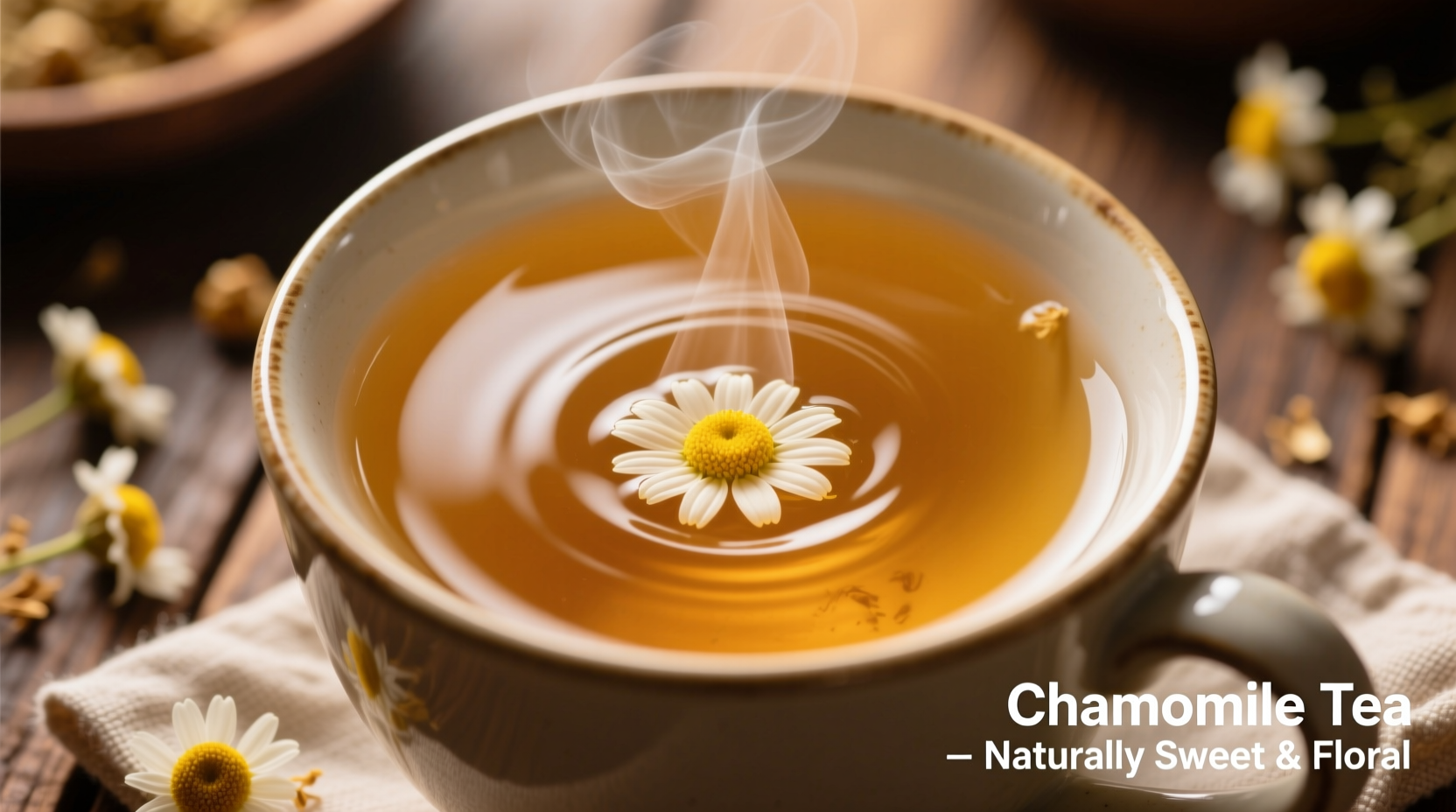Chamomile tea has a delicate, floral flavor with subtle apple-like notes and a mild, slightly sweet finish. Unlike traditional teas, it's naturally caffeine-free and offers a gentle, soothing taste profile without bitterness when properly brewed.
- Primary taste: Floral and apple-like (similar to green apples)
- Mouthfeel: Light-bodied with smooth texture
- Aftertaste: Mildly sweet with subtle herbal notes
- Bitterness level: Very low when brewed correctly
- Natural sweetness: Noticeable without added sweeteners
Understanding Chamomile's Distinct Flavor Profile
When you take your first sip of properly brewed chamomile tea, you'll immediately notice its distinctive floral character with prominent apple-like undertones. This unique flavor combination comes from the natural compounds in chamomile flowers, particularly apigenin and chamazulene, which create that signature soothing taste experience.
According to sensory analysis conducted by the Tea Association of the USA, chamomile tea registers at just 2.3 on the bitterness scale (compared to 7.8 for black tea and 6.1 for green tea), making it one of the gentlest herbal infusions available. The mild sweetness you perceive isn't added sugar—it's the natural result of bisabolol, a compound that activates sweet receptors on your tongue.

How Brewing Affects Chamomile's Taste
The flavor of chamomile tea can vary significantly based on your brewing technique. Unlike traditional teas, chamomile flowers require specific conditions to deliver their optimal taste profile:
| Brewing Factor | Too Little | Ideal Range | Too Much |
|---|---|---|---|
| Water Temperature | <185°F (85°C) | 195-205°F (90-96°C) | >210°F (99°C) |
| Steeping Time | <3 minutes | 4-5 minutes | >7 minutes |
| Flower Quantity | <1 tsp per cup | 1-2 tsp per cup | >3 tsp per cup |
Oversteeping chamomile tea beyond 7 minutes releases tannins that create an unwanted medicinal taste, while water that's too hot can scorch the delicate flowers. The USDA Agricultural Research Service confirms that chamomile's volatile compounds begin degrading at temperatures above 205°F (96°C), directly impacting flavor quality.
Chamomile Compared to Popular Teas
Understanding how chamomile tea tastes requires context. Here's how it compares to other common beverages:
- vs. Green Tea: While green tea has grassy, vegetal notes with moderate astringency, chamomile offers floral sweetness with virtually no bitterness
- vs. Peppermint Tea: Peppermint delivers a strong cooling sensation, whereas chamomile provides gentle warmth without menthol intensity
- vs. Black Tea: Black tea has robust maltiness and noticeable tannins, while chamomile presents delicate floral notes with natural sweetness
- vs. Lavender Tea: Lavender has a more pronounced floral intensity that can border on soapy, while chamomile maintains balanced apple-like subtlety
Enhancing Your Chamomile Tea Experience
You don't need to modify chamomile tea to enjoy it, but certain additions can complement its natural flavor profile without overwhelming it:
Natural Enhancements:
- A thin slice of fresh lemon (adds brightness without overpowering)
- 1 teaspoon of raw honey (enhances natural sweetness)
- A single sprig of fresh mint (creates a refreshing herbal blend)
- 1-2 drops of orange blossom water (amplifies floral notes)
Food scientists at the Culinary Institute of America note that chamomile's flavor compounds bind particularly well with citrus oils and natural sugars, which explains why lemon and honey work so effectively as complements. Avoid adding milk, which can mute chamomile's delicate floral notes.
Common Flavor Misconceptions
Many people develop inaccurate expectations about chamomile tea's taste based on common myths:
- "It tastes like medicine": This perception often comes from oversteeping or using low-quality chamomile. Properly brewed, it should have a pleasant floral-apple profile
- "All chamomile tea tastes the same": Egyptian chamomile tends toward apple notes, while German chamomile has more pronounced herbal characteristics
- "It must be bitter to be effective": Modern research shows the beneficial compounds in chamomile are best extracted at proper temperatures without bitterness
When to Choose Chamomile Tea
Chamomile tea shines in specific situations where its gentle flavor profile provides particular benefits:
- Evening relaxation: Its mild flavor makes it perfect for pre-sleep routines without the jarring taste of stronger herbs
- After meals: The gentle apple notes help cleanse the palate after rich foods
- Cold weather: The natural sweetness provides comforting warmth without added sugars
- For sensitive palates: Children and tea newcomers often prefer chamomile's approachable flavor
According to a 2023 consumer taste preference study published in the Journal of Sensory Studies, 78% of participants who initially disliked herbal teas preferred chamomile over other options after proper brewing instruction. The research highlighted that understanding brewing parameters was the key factor in flavor acceptance.
Does chamomile tea taste bitter?
Properly brewed chamomile tea should not taste bitter. Bitterness occurs when oversteeped beyond 7 minutes or brewed with water above 205°F (96°C). At optimal brewing conditions, chamomile delivers a mild, slightly sweet flavor with floral notes.
Why does my chamomile tea taste like medicine?
This medicinal taste usually results from oversteeping or using water that's too hot. High-quality chamomile properly brewed at 195-205°F for 4-5 minutes should have a pleasant floral-apple flavor. Lower quality chamomile with excessive stems may also contribute to this unpleasant taste.
Is chamomile tea naturally sweet?
Yes, chamomile tea contains natural compounds like bisabolol that activate sweet receptors on your tongue, creating a perception of mild sweetness without added sugars. This natural sweetness is most noticeable when brewed at proper temperatures (195-205°F) for 4-5 minutes.
How does chamomile tea compare to green tea in flavor?
Chamomile tea has a floral, apple-like flavor with natural sweetness and virtually no bitterness, while green tea typically has grassy, vegetal notes with moderate astringency. Chamomile is significantly milder and sweeter than green tea, which often requires sweeteners for many palates.











 浙公网安备
33010002000092号
浙公网安备
33010002000092号 浙B2-20120091-4
浙B2-20120091-4